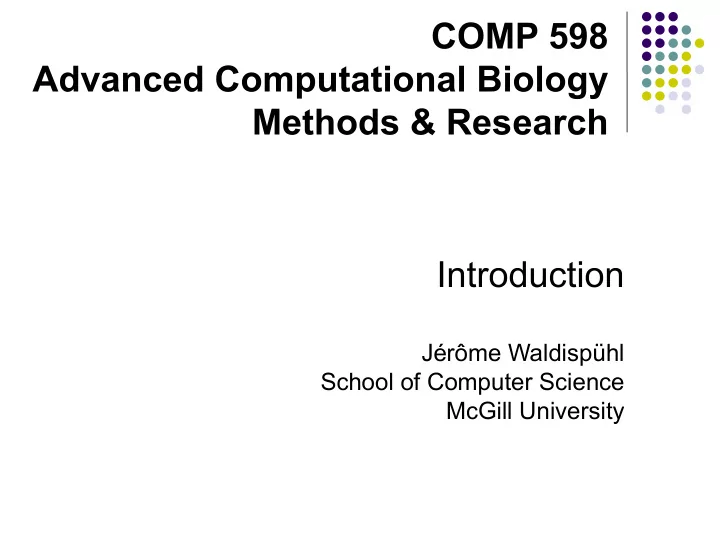

COMP 598 Advanced Computational Biology Methods & Research Introduction Jérôme Waldispühl School of Computer Science McGill University
General informations (1) Office hours: by appointment Office: TR3018 Contact: jerome.waldispuhl@mcgill.ca Web: Go to “My Course”
General informations (2) Evaluation: • 2 assignments (15% each) • 2 paper reports & presentations (10% each) • 1 project (45%) • Participation (5%)
General informations (3) Objective: Extends COMP462/561 Topics: Structural Bioinformatics & System Biology Background: Algorithmic, Programming & Basic knowledge in Molecular Biology Invited lectures
Central dogma of biology DNA Transfer RNA Transcription RNA Translation RNA-Protein interactions Ribosome Protein Function Etcetera… Protein-protein interactions (Images not to scale)
The 3 components of the Bioinformatics 1. Genomic: Study of an organism's entire genome. Huge amount of data, limited to the sequence. 2. System Biology: Study of complex interactions in biological systems. High-level of representation, practical interests. 3. Computational Structural Biology: Study of the bio-molecule folding process. Lack of data in early year of bioinformatics, step toward the function, fill the gap between genomic and system biology.
Part 1 Computational Structural Biology
Modeling structures RNA Protein We introduce a intermediate representation (secondary structure) between the sequence (primary) and the 3D structure (tertiary).
Classification of structure & folding prediction methods Structure prediction § Comparative/Homology modeling: similar sequences fold the same. § Threading/Fold recognition: fold a sequence on a known 3D template. § Ab-initio method: Sampling the conformational space. Folding pathway prediction: § Molecular dynamics: simulation under known laws of physics. § Motion planning: simulation of atomic robotic motions. § Coarse grained model: Discrete modeling of the folding landscape
Protein Structure: amino acids The 20 amino acids. Building blocks of a protein. They differs by the nature of their side-chain (radical).
Proteins: Peptide bond The sequence of amino acids is called the primary structure
Protein secondary structure: α -helices Features: § 3.6 amino acids per turn, § hydrogen bond between residues n and n+4, § local motif, § approximately 40% of the structure.
Protein secondary structure: β -sheets Features: § 2 amino acids per turn, § hydrogen bond between residues of different strands, § involve long-range interactions, § approximately 20% of the structure.
Protein secondary structure: Turns Features: § Up to 5 residue length, § hydrogen bonds depend of type, § local interactions, § approximately 5-10% of the structure.
§ Secondary structure element are assembled together to form the tertiary structure . § Complexes built from more than one chain form a quaternary structure .
RNA structure Base-pair Maximal planar representation (no crossing edges) of the graph of the base-pairs (watson-crick + wobble). (More details in the next lecture.)
Databases § Protein Data bank: www.rcsb.org (3D structures) § MSD-EBI: www.ebi.ac.uk/msd (3D structures) § PDBj: www.pdbj.org (3D structures) § UniProtKB/Swiss-Prot: expasy.org/sprot (annotated protein) § CATH: cathdp.info (structure classification) § SCOP: scop.mrc-lmb.cam.ac.uk/scop (structure classification) § BMRB: www.bmrb.wisc.edu (NMR) § NDB: ndbserver.rutgers.edu (ARNs)
Protein Data Bank
PDB format Keywords: SEQRES: amino acid or nucleic acid sequence. MODRES: descriptions of modifications to residues. HELIX: identify the position of helices in the molecule. SHEET: position of sheets in the molecule. TURN: identify turns and other short loop turns. ATOM: atomic coordinates for standard residues. HETATM: atomic coordinate of atoms within "non-standard" groups. CONECT: connectivity between atoms for which coordinates are supplied. HYDBND: specify hydrogen bonds in the entry. SSBOND: disulfide bond.
PDB format (2) COLUMNS DATATYPE FIELD DEFINITION 1- 6 Record name "ATOM " 7-11 Integer serial Atom serial number. 13-16 Atom name Atom name. 17 Character altLoc Alternate location indicator. 18 - 20 Residue name resName Residue name. 22 Character chainID Chain identifier. 23 - 26 Integer resSeq Residue sequence number. 27 Char iCode Code for insertion of residues. 31 - 38 Real(8.3) x Orthogonal coordinates for X in Angstroms. 39 - 46 Real(8.3) y Orthogonal coordinates for Y in Angstroms. 47 - 54 Real(8.3) z Orthogonal coordinates for Z in Angstroms. 55 - 60 Real(6.2) occupancy Occupancy. 61 - 66 Real(6.2) tempFactor Temperature factor. 73 - 76 LString(4) segID Segment identifier, left-justified. 77 - 78 LString(2) element Element symbol, right-justified. 79 - 80 LString(2) charge Charge on the atom.
Classical secondary structure prediction algorithms. Lecture 2: Classical secondary structure prediction algorithms. Lecture 3: RNA sequence/structure alignment. Lecture 4: Stochastic secondary structure prediction. RNA dotplot
Extended secondary structures Lecture 5: RNA saturated secondary structures and RNA shapes. Lecture 6: RNA secondary structures with pseudoknots, RNA-RNA interaction. RNA-RNA interaction Pseudo-knotted RNA secondary structure:
Lecture 7-9: Theoretical studies in the RNA secondary structure model Lecture 7: Grammatical modeling of RNA structures. Lecture 8: Asymptotics of RNA secondary structures Lecture 9: Evolution, neutral network. Lecture 10: Synthetic Biology, RNA design. Grammatical modeling of RNA structure Connected neutral network
Lecture 11-13: Advanced topics Lecture 11: RNA 3D structure modeling, alignment and prediction. Lecture 12: Genomic identification of structural RNAs Lecture 13: RNA folding kynetics
Lecture 14-15: 3D modeling and simulation Lecture 14: Introduction to protein structure prediction. & Conformational search and Molecular Dynamics. Lecture 15: Threading, fragment assembly, side-chain packing.
Lecture 16-18: template based predictions Lecture 16: Protein secondary structure prediction. Lecture 17: Language theory as a tool for protein structure modeling and prediction. Lecture 18: Transmembrane proteins. HMM modeling of transmembrane beta-barrel (Bigelow et al., 2010)
Lecture 19-21: Folding pathways Lecture 19: Protein folding on a lattice models. Lecture 20: Residue contact prediction & folding pathways. Lecture 21: Integrative methods. Protein folding in HP model Folding landscape
Part 1 System Biology
Protein-protein interaction networks
Gene interaction network (Magtanong et al., 2010)
Lecture 22-23: Algorithms for interaction network Lecture 22: Modeling interaction network Lecture 23: Networks alignments & evolution . IsoRank (Singh et al., 2008)
Lecture 24: Unifying Structural & System Biology (Lieberman-Aiden et al., 2009)
Recommend
More recommend